Clark Fork Project
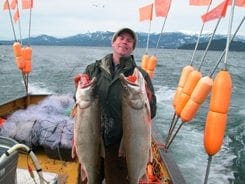
Summary
In northern Idaho, picturesque Lake Pend Oreille is home to a prized destination fishery. Kokanee salmon form the backbone of the fishery, which is valued at more than $17 million annually. In the early 1990s, Idaho Department of Fish and Game began observing increasing numbers of lake trout in Lake Pend Oreille. By 2000 the kokanee fishery had been closed and measures had been taken to increase harvest on both lake trout and rainbow trout to reduce predation on kokanee. Kokanee are also a critical food source for the bull trout, a federally-listed threatened species. By 2005, it was clear that the Lake Pend Oreille kokanee fishery was on the verge of collapse. Through a multi-faceted collaborative effort, Avista, Idaho Department of Fish and Game, Lake Pend Oreille Idaho Club and others are working together to reduce the population of lake trout through commercial netting, angler incentives and education programs. Altogether, these efforts are an attempt to save a listed native species and one of Idaho’s most valuable fisheries.
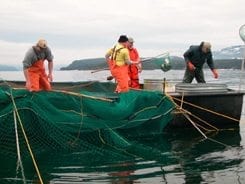
Background
The Clark Fork Hydroelectric Project (FERC License 2058), is owned and operated by Avista Utilities, and consists of the Cabinet Gorge and Noxon Rapids hydroelectric developments. Noxon Rapids and Cabinet Gorge are located along the lower Clark Fork River, in northern Idaho and northwest Montana and received a new federal operating license that became effective in 2001.
Lake Pend Oreille (LPO) is located in northern Idaho, seven miles downstream of Cabinet Gorge Hydroelectric Development. A destination recreation fishery with more than 94,000 surface acres and 1,152 feet of depth, LPO is one of the largest, deepest freshwater lakes west of the Mississippi. Recent economic surveys estimate the fishery is worth about $17 million annually. LPO tributaries drain over 24,200 square miles of Idaho and Montana and provide key spawning and rearing habitat for the federally-listed, threatened bull trout. During the relicensing process for the Clark Fork Project in the late 1990’s, recovery of bull trout was identified as the priority fisheries mitigation activity. Due to the possible impacts of ongoing peaking operation and the potential for Cabinet Gorge to harm water quality by adding total dissolved gas to the water, through the relicensing process Avista established a collaboratively-managed mitigation effort that extends to LPO and its tributaries. The mitigation process is managed by Avista, and overseen by a group of stakeholders known as the Clark Fork Project Management Committee (CFMC) and including representatives from federal and state agencies, tribes and NGOs.
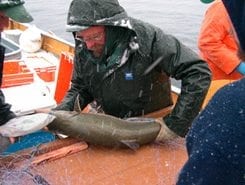
Challenge
Over the past sixty years, LPO fisheries have faced a number of challenges, including the legal and illegal introduction of numerous exotic fish species, such as Mysis shrimp. Kokanee salmon were established in the lake in 1933, have become central to the prized recreation fishery, and are a key forage species for the native bull trout and the introduced rainbow trout. In 2000, research identified that an already depressed LPO kokanee population was in serious trouble, as a result of predation. (In other northwest lakes where Mysis shrimp and lake trout have become established, kokanee populations collapsed in some case to the point of extinction, followed by drastic declines in bull trout populations.) During 2000, the Idaho Fish and Game Commission approved emergency rules which closed the kokanee fishery to harvest, removed take limits on lake trout, and liberalized take limits on rainbow trout. At the same time, Idaho Department of Fish and Game (IDFG) embarked on a public information program to encourage anglers to harvest rainbow and lake trout. Angler response was insufficient to curb growth in the lake trout population, and predation by rainbow trout continued to prevent kokanee recovery.
At the request of IDFG, in 2003 and 2005 Avista contracted with Harbor Fisheries to experiment with commercial trap nets as a tool for capturing lake trout. Due to social concerns, the nets were only used to make an estimate of lake trout population size, and no lake trout removal occurred. Anglers were still encouraged to harvest predators, and in 2005 additional incentives (funded by Avista) were provided for lake trout harvest during fishing derbies. Trap netting during fall of 2005 revealed the lake trout population had grown, and acoustic data revealed that kokanee populations were extremely challenged. Meanwhile, many anglers continued to express doubts about the likelihood of a collapse of the fishery and reservations about the use of nets to suppress lake trout.
By the fall of 2005, it was clear to IDFG there was an emergency situation and without a significant reduction in rainbow and lake trout, the kokanee population would collapse within four years. The collapsing kokanee population would reduce forage opportunities for bull trout, a major concern to Avista and others. Together, IDFG, Avista, and the Clark Fork Project Management Committee set out to use the collective energy of the public and Avista mitigation funding to save the LPO kokanee fishery. The major objectives involved immediate development and implementation of predator management strategies to prevent a kokanee collapse, and providing guidance for species-specific goals for incorporation into the 2007-2012 Statewide Fishery Management Plan. Measures of success include assessment of kokanee survival rates, calculation of exploitation rates of rainbow and lake trout, and determining long-term population reduction targets for both species.
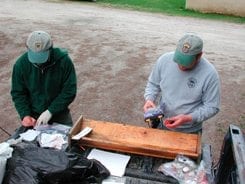
Innovation
Saving the collapsing fishery involves a multi-faceted effort, with goals based on the research of Dr. Mike Hansen, Fisheries Professor University of Wisconsin, Stevens Point. Under contract with Avista and IDFG, Hanson developed a population dynamics model including management implications, which provided the basis for exploitation and recovery goals. In 2006, Avista contracted with Harbor Fisheries to begin lake trout suppression. This effort included use of trap nets, gill nets, baited cod traps and set lines, at a cost of approximately $250,000. As approved by the CFMC, Avista will also provide up to $15,000 for an evaluation of lake trout exploitation, and $12,000 to pay anglers to assist with PIT tagging of rainbow trout for a mark/recapture population estimate.
In addition to research, public education and buy-in was identified as critical to the success of the recovery effort. IDFG formed a Lake Pend Oreille fishery Recovery Task Force, composed of anglers, marina owners, charter boat captains and general public to assist in getting the word out, while Avista shared information through the Clark Fork Management Committee representatives, who also approved $20,000 for the education effort. Avista utilized a public relations program to develop media articles on proposed programs and update the public regarding progress. Avista also contracted for the development of two videos designed to increase anglers’ effectiveness in catching lake trout and rainbow trout. Free copies of the videos were placed at IDFG offices and libraries. Two additional Avista-funded fishing seminars also focused on angler efficacy.
Anglers also received encouragement to harvest rainbow trout and lake trout through a structured incentive program approved by the CFMC and funded by Avista at a cost of $279,000 in funding to pay for angler incentive awards. The original structure of the Angler Incentive Program included PIT tag rewards, monthly cash drawings and individual lottery tickets for every fish entered from the end of April to August. In addition to the Avista-funded program, the Lake Pend Oreille Idaho Club ran their own “Last Chance Predator Derby” in early June to evaluate the effectiveness of bounties to encourage anglers to harvest predators. The results were encouraging, so the IDFG task force agreed to use about $15,000 of Avista funding for another predator derby in August. As a result of the successful derbies, at the end of August, a bounty incentive was initiated for rainbow and lake trout. In a unique cooperative effort, the bounty program is funded by Avista administered by LPOIC to avoid IDFG overhead charges.
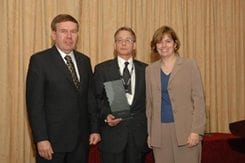
(left to right) Dave Youlen, John Whittaker representing Avista Utilities & Julie Smith Galvin)
Results
Although these efforts have only been underway for a short time, initial results are reason for cautious optimism. Since April 29 through November 30, 2006, anglers had killed 16,610 rainbow and lake trout through the use of angler incentives. Another 4,387 were removed using trap nets and gill nets since the spring of 2006. Based on Dr. Hansen’s research, exploitation was at approximately 42.4%, with additional fishing still occurring during December. Annual exploitation is just above the 50% exploitation rate deemed necessary to achieve successful population reduction. Measures including assessment of kokanee survival rates, determination of exploitation rates, and development of long and short term population reduction targets will continue over time, helping to shape future efforts.
Short term successes include the relatively quick transition from program conceptualization to implementation, due to the collaborative efforts of Avista Utilities and their Clark Fork Project stakeholders, IDFG and the citizens’ task force, the Lake Pend Oreille Idaho Club, and the public. The flexibility and adaptive management concepts that are keys to Avista’s mitigation program allowed for major program shifts and fund allocations in a short timeframe. Successful communication with the public is a second element of success, for although population reduction of the trophy trout fishery is controversial, communication efforts have helped the public understand the necessity of reducing predator numbers to prevent a kokanee collapse. In terms of cost effectiveness, Avista’s 2006 investment of $831,100 is considered an investment to save a priceless fishery. Overall, the process, programs and relationships developed will ensure a smooth and unified front as we attempt to save a threatened species and one of Idaho’s most valuable fisheries.
Stakeholder Quotes
“Suppressing lake trout and restoring a healthy prey population of kokanee are vital to bull trout conservation efforts system, as Lake Pend Oreille supports one of the foremost lake dwelling populations of bull trout remaining in N. America. The suppression project is also critical to restoring what was once the most popular sport fishery in the state of Idaho, and will ensure that other Avista funded conservation projects such as fish passage and tributary habitat restoration will be successful. The innovative project, which incorporates both angler incentives and the use of commercial netting gear, would not be possible without the financial support provided by Avista through the stakeholder driven Clark Fork Management Committee. As importantly, the collaborative nature of the group provides for open discussion and critical review of the project, helping to ensure it is both biologically sound and socially accepted.” — Charles “Chip” Corsi, Idaho Department of Fish and Game
“The world class fisheries of Lake Pend Oreille are threatened by the collapse of the kokanee fishery and loss of trophy rainbow and native bull trout. Fortunately, Avista created a unique collaborative process and a significant funding base that encourages innovative solutions to help solve complex problems. This fishery recovery effort would not be possible without Avista support.” — Ned Horner, Idaho Department of Fish and Game
“The Lake Pend Oreille Idaho Club is a 62-year-old non-profit organization dedicated to the preservation and enhancement of Lake Pend Oreille and its fishery. Over the past few years a united effort has been underway to understand and manage aggressive species that affect this great fishery. Avista, Idaho Department of Fish and Game and the Lake Pend Oreille Idaho Club as well as local citizens have all participated in a predator suppression program. Our organization has been proud to participate in this collaborative effort. We are confident and optimistic that this group will meet future challenges and together we will enhance this trophy fishery for generations to come.” — Bill Friedmann, Lake Pend Oreille Idaho Club President


